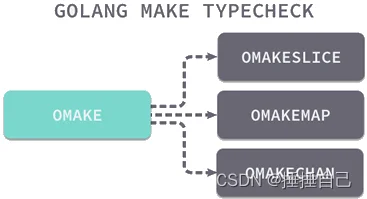new和make
new
// The new built-in function allocates memory. The first argument
// is a type,not a value, and the value returned is a pointer to a
// newly // allocated zero value of that type.
func new(Type) *Type
new使用new初始化
newThe built-in function new takes a type T and returns a value of type *T. The memory [pointed to] is initialized as described in the section on initial values.零值
0""falsenil使用示例(new也可以为数组分配内存)
a := new(int)
fmt.Printf("类型为:%T, 值为:%v\n", a, a)
fmt.Printf("类型为:%T, 值为:%v\n", *a, *a)
b := new(string)
fmt.Printf("类型为:%T, 值为:%v\n", b, b)
fmt.Printf("类型为:%T, 值为:%v\n", *b, *b)
c := new(*int)
fmt.Printf("类型为:%T, 值为:%v\n", c, c)
fmt.Printf("类型为:%T, 值为:%v\n", *c, *c)
运行结果:
类型为:*int, 值为:0xc0000a6058
类型为:int, 值为:0
类型为:*string, 值为:0xc000088220
类型为:string, 值为:
类型为:**int, 值为:0xc0000ca020
类型为:*int, 值为:<nil>
new(struct)和&struct{}区别
struct{}&struct{}new(struct)new&struct{}func main(){
A := new(struct) // 只能返回一个struct的指针
B := &struct{Id:1,Name:"张三"} // 可以返回一个带有默认值的struct的指针
}
上述例子就很好的说明了这个问题。
小结
newnewnewnewmake
// The make built-in function allocates and initializes an object of type // slice, map, or chan (only). Like new, the first argument is a type, not a // value. Unlike new, make's return type is the same as the type of its // argument, not a pointer to it. The specification of the result depends on // the type:
func make(t Type, size ...IntegerType) Type
make(slice/map/channel)newmakemakemakenewchan、mapslice简述make的初始化(slice/map/channel)

makeslice/map/channelmakeOMAKEMAKESLICE、OMAKEMAP、OMAKECHAN使用示例
var a []int
fmt.Println(a[0])
// 运行结果
panic: runtime error: index out of range [0] with length 0
如果不对切片进行初始化,就无法使用
var a []int
a = make([]int, 1)
fmt.Println(a[0])
mapchanmapmap0mapchannel总结:
makenewnewint、string、数组makeslice、map、channelnewmakenewmakenewnewmakeslice,map,和channelnew参考资料
go语言中文网
深入学习golang
